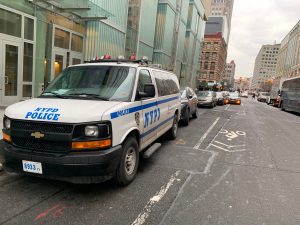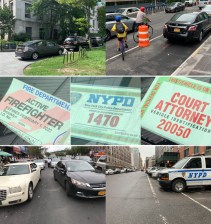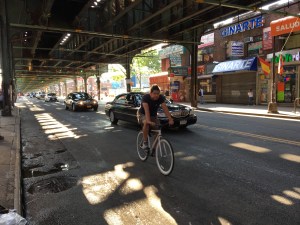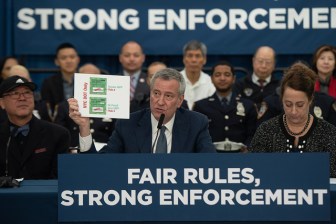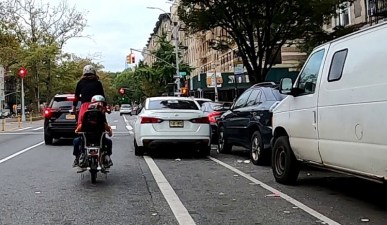Civilian Enforcement: A Get-Rich-Quick Scheme That Also Makes the City Safer


Want to make a six-figure salary and never leave your neighborhood?
It’s not a cheesy internet come-on. It’s civilian reporting of parking violations — the new remote work opportunity. Thanks to a bill pending before the City Council, you could soon be making big bucks while helping keep the roads of your neighborhood safe and deterring illegal parking. It’s a win-win-win (again, that’s no Twitter ad scam!).
Intro. 501, sponsored by Council Member Lincoln Restler, imposes a penalty of $175 for “parking, stopping or standing in a bike lane or bus lane or in front of a hydrant anywhere within a 1,320-foot radius of a school.” But here’s where you come in: The bill also requires the city to kick back 25 percent of collected fines to the civilian who files the complaint — the same basic scheme as the program to report idling commercial vehicles (the “Billy Never Idles” approach).
It’s like 311, but in this case, you are dialing for dollars. In this case, about $43 per violation. To be clear, the goal of the bill is not to mint new millionaires every year, but to crack down on illegal parking that creates dangerous street conditions. And judging by how quickly I earned my daily bread, it’s very clear that dangerous parking is an endemic problem that needs an immediate fix.
First, some ground rules: the bill’s 1,320-foot radius from a school covers several city blocks in any direction — and even with only a handful of schools, the overlapping radii make Chinatown and Tribeca two very target-rich areas in a neighborhood known for scofflaws.

I also assume the resulting program will require a photo of the violation, so I paused long enough to take them and note the time and locations.
To find out how much money a civilian could make under the new bill in the equivalent of an eight-hour workday, I went out on patrol near two schools in my neighborhood: Transfiguration School on Mott Street in Chinatown and P.S. 234 on Greenwich Street in Tribeca.
In the first hour in Chinatown, I spotted five cars blocking hydrants. Those five violations, at $175 each, would yield $656.25 for the city and $218.75 for me. One more hour yielded six more infractions, bringing the two-hour total to 11 — or a possible $481.25 in bounties. Not bad for a job with no heavy lifting.
Later, I headed to Greenwich Street, where I spent another two hours wandering around, nabbing six cars and trucks in the act of obstructing crosswalks or blocking hydrants.
So in just four hours, I logged 17 hazardous obstruction violations, which would mean $2,231 in the city coffers and about $744 in my pocket.
Do the math: If I put in four hours of work per day, I’d earn $178,560 per year — even giving myself a generous four-week vacation. If I wanted to work eight hours a day, and cut my vacation time down to three weeks, I’d earn $364,560 per year. And that’s not even calculating the job’s health benefits … of all the exercise I’d get!
Intro 501, which would allow the public to report dangerously parked cars obstructing bus and bike lanes, crosswalks, fire hydrants, or sidewalks and get 25% of the ticket money now has 26 co-sponsors, a majority of the City Council. pic.twitter.com/9VKbFtgXoC
— Philip Miatkowski (@miatkowski) December 7, 2022
https://platform.twitter.com/widgets.js
The Restler bill is not motivated by the desire to create a new side hustle, but by the serious issues of street safety and abuse of power.
“Every day thousands of government officials and city contractors use their privilege in neighborhoods across New York City by misusing government-issued placards or using fake placard to park illegally,” Restler said when introducing the legislation. “This is not just an abuse of power. It’s a public safety risk. These cars illegally obstruct pedestrian space, endanger cyclists, and block accessibility.”
I asked him what he thought about my six-figure side hustle, but he didn’t take the bait.
“The point of Intro 501 is to effectively deter dangerous parking that block bike lanes, bus lanes and sidewalks — not to generate revenue,” he said. “And identifying that many violations in such a short period of time indicates we have a major safety issue that needs to be swiftly addressed.”
So far this year, there have been 1,066 reported crashes below Canal Street injuring 71 cyclists and 79 pedestrians, according to city stats. We don’t know how many people were injured because of illegally parked cars, but my four-hour experience as a civilian enforcement officer shows that there are so many illegally parked cars causing hazardous obstructions for pedestrians, cyclists and other motorists.
Almost everyone acknowledges the problems of illegal parking and other obstructions caused by car drivers, but as Restler is finding, there is by no means universal agreement on the civilian reporting mechanism, which is expected to pass next year.
“I’m not sure I support dispatching citizens to help enforce traffic laws,” said Mona, a lawyer who declined to give her last name. She did recognize the “monumental problem” of illegally parked cars in Tribeca.
I’m inclined to side with Restler on this (and not because of my dreams of a wallet as big as the Ritz): “We have complex crises in our city from housing to climate,” Restler said, turning his attention to placard abuse and illegal parking. “They are by no means the most urgent, but they are among the easiest to solve. So there is no reason to wait.”
